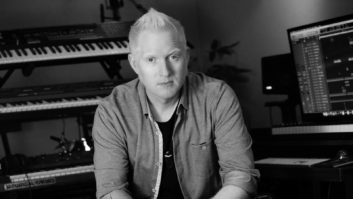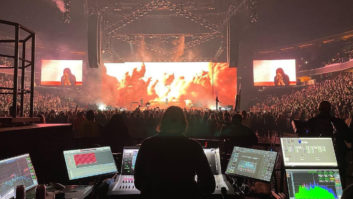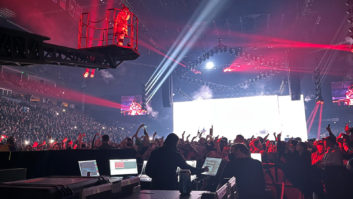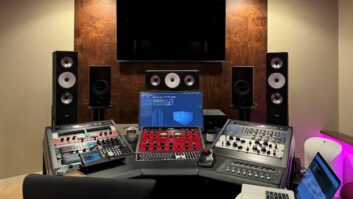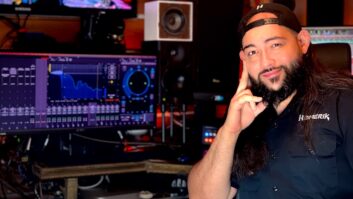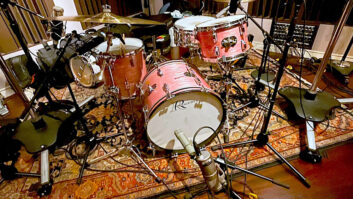Los Angeles, CA (May 23, 2019)—Much has been made of the fact that virtually everything Billie Eilish has released with her co-writer, producer and older brother Finneas O’Connell was recorded in his bedroom at the family home. That’s hardly surprising when you consider her career trajectory, going from a song posted in late 2015 to Soundcloud for a dance class that blew up almost overnight to becoming the first artist born in the 21st century to have a Number-One album on the Billboard 200, in early April 2019.
In the intervening three and a half years, Eilish (full name: Billie Eilish Pirate Baird O’Connell) racked up one billion on-demand streams before releasing her debut full-length, When We All Fall Asleep, Where Do We Go?—Nielsen Music reported that she had passed 3.79 billion streams by April 25—and has seen 12 of the 14 album tracks, plus two other songs, hit Billboard’s Hot 100. Not bad for a 17-year-old who, incidentally, is now the youngest female ever to have a Number-One album in the UK.
“People have put a lot of emphasis on that room as part of our lineage,” says O’Connell on the phone from Australia during a tour leg on which he both opened for, as a solo artist, and performed with Eilish. “It was lovely to make an album there, but I think it’s really important to work wherever you are, or wherever you have your tools.”
This is no humblebrag bedroom studio that turns out to have been professionally outfitted. It’s just a regular bedroom, with a bed against one wall, where Eilish sat to record her vocals, facing a desk and bookshelves and O’Connell’s modest production setup: Apple Logic Pro X, a Universal Audio Apollo 8 interface and a pair of Yamaha HS5 nearfields with an H8S subwoofer. O’Connell, who turns 22 in July, has since moved out, setting up a duplicate, slightly upgraded collection of gear at his new home, including a pair of Yamaha HS8 monitors and an Apollo X.
As his sole reference, O’Connell says he didn’t really think about the way the bedroom sounded until he started recording elsewhere. “The bedroom has a very specific sound, very tight and intimate and closed and quiet. I love the way it makes vocals sound.”
Eilish’s next album could potentially sound a little different. “All of my solo material, I record at my new house. I’m sure Billie and I will start recording there whenever we get back into recording mode for the next record,” he says. “But even if we never record full albums there again, maybe sometimes there will be just a vocal that we feel we must record in that room just to make it sound that way.”
Eilish’s hip-hop-influenced yet pan-genre songs (she calls it simply “Billie Eilish music”) sometimes feature heavily effected vocals, and harmonies that are equal in level to the lead—not to mention sound effects such as an Easy-Bake oven, dentist drill and audience reaction. “Especially in a song like ‘Bad Guy,’ the thing that’s interesting isn’t necessarily the vocal melody on the verses; it’s that there’s three-part harmony and it’s the rhythm,” says O’Connell.
The secret behind some of those vocal effects is Logic Pro X’s Vocal Transformer plug-in, he reveals. “It’s really good at making a vocal sound crazy and unique. It’s not necessarily the most intuitive plug-in, but if you twiddle the knobs and change some dials, it makes things really interesting. That’s the plug-in I use on ‘Bad Guy’ for the ‘rattlesnake’ vocal.”
Other than that, he says, “I use really harsh tremolo a lot. It’s set to zero percent smooth, so it’s chopping the signal, and I’ll set it to eighth- or sixteenth-note values, then set the depth.”
When initially working together, a period that included the production of songs such as “Ocean Eyes,” “Six Feet Under” and “Bellyache,” O’Connell used an Audio-Technica AT2020 cardioid condenser mic on his sister’s vocals. More recently, he has been using a Neumann TLM 103 large diaphragm mic. “I recommend the TLM 103 to anyone; it’s such a good microphone.” But when he has some free time, he says, “I’ll probably do a microphone shootout somewhere and try a bunch of different things.”
In fact, he bought a pair of TLM 103s and hopes to use them to record his piano eventually, but for Eilish’s productions, he has always used virtual instruments, such as Keyscape by Spectrasonics. “It’s amazing, especially the Dark Indie upright pianos. My piano in my parents’ room is not situated well for recording. It’s more fun to write on it, then record on a MIDI keyboard, especially because I like tweaking MIDI parts, changing and perfecting them.”
O’Connell hands Eilish’s songs off to mixer Rob Kinelski. “Everything that I’ve sent that he’s mixed is pre-compressed and pre-panned, and all the reverbs and all the delays are pretty much already there. I’m not looking for Rob to ‘fix’ anything; he just makes it a little more balanced, because everything comes out of my bedroom at my parents’ house with too much bass. Rob and our mastering engineer, John Greenham, make sure our stuff sounds good everywhere.”
O’Connell has been using Justin Hergett, a Grammy-nominated mixer and engineer who has long worked with Tony Maserati as chief engineer of Mirrorball Entertainment’s Outfit 27 team, to mix his solo work, as well as projects with artists such as Ashe, whose four-song EP he executive produced. “Hergett is really fast,” he says. “It’s fun to go into the room with the mixer and watch what they do; he’s always been very nice about letting me do that.”
While Finneas O’Connell can now afford to employ a mixer and mastering engineer on his productions, it wasn’t always that way. But lack of a budget should not be a barrier to anyone starting out in the business, he says.
Take “Ocean Eyes,” for example—the song that went viral and caught the attention of the management team and record label now behind Eilish. “It was mixed and mastered by me and uploaded to Soundcloud. And that song saved our lives,” says O’Connell.
“When I was starting to make music, I thought I had to pay a bunch of people to do all my things professionally and that that would be the only way I would ever have any success. It’s really important for kids to not think that there’s something intangible and out of reach for them. The truth is that you just have to make a song that people like.”
Billie Eilish • https://site.billieeilish.com
Finneas • www.finneasofficial.com
